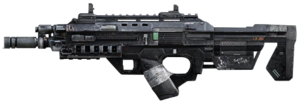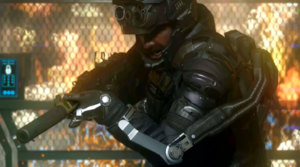R-27
This article is incomplete because it is pending further input from participants, or it is a work-in-progress by one author. Please comment on this article's talk page to share your input, comments and questions. Note: To contribute to this article, you may need to seek help from the author(s) of this page. |
| R-27 | |
|---|---|
 OCorp R-27 with iron sights | |
| Type | Bullpup assault rifle |
| Place of origin | |
| Service history | |
| In service | 2016-present |
| Used by | Yugobatania |
| Production history | |
| Designer | OCorp Weapons Research Division |
| Designed | 2014 |
| Manufacturer | O Corporations |
| Unit cost | $850 (avg. cost) |
| Produced | 2015-present |
| No. built | Approx. >25,000 |
| Variants | See Variants |
| Specifications | |
| Weight | 3.26 kg (7.2 lb) with 30 rounds |
| Length | 27.3 in (695 mm) |
| Barrel length | 16.3 in (414.02 mm) including flash suppresor |
| Cartridge | 5.56×45mm OCP |
| Caliber | 5.56 mm (.223 in) |
| Action | Straight blowback, closed bolt |
| Rate of fire | 857 rounds per minute |
| Muzzle velocity | 2,970 ft/s (910 m/s) |
| Effective firing range | 500m (1,640 ft) |
| Maximum firing range | 1,200m (3,937 ft) |
| Feed system | 30-round magazine |
| Sights | Iron sights or various optics |
The R-27, officially known as the OCorp Rifle No. 27, is a straight blowback, 5.56×45mm bullpup assault rifle, developed in Yugobatania by O Corporations in 2014. It replaced the various assault rifle models that were already present in the Yugobatanian inventory; this was done to help cut down production costs and to have a weapon that could fulfill the requirement for a "universal infantry weapon" to be issued to all services.
The R-27 was designed as a medium-range assault rifle, and has exceptional firing rate, being able to fire up to 857 rounds per minute. It was the first assault rifle designed by OCorp, and has become the standard service rifle since then.
Featuring a fairly compact bullpup design with fully ambidextrous controls, the R-27 is an unconventional weapon with a futuristic appearance. Its design incorporates several innovations such as its unique top-mounted magazine and high-velocity 5.56×45mm ammunition. Additional integrated features include interchangeable visible or infrared laser and tritium light source.
History
Development
Development of the R-27 began in early 2014 by the OCorp Weapons Research Division, the main branch of OCorp focused on producing and designing firearms for the company. The R-27 itself was created to fulfill a 1985 proposal, titled Экспериментальное предложение по винтовке № 1640 (Experimental Rifle Proposal No. 1,640), by the former Federal Republic of Yugobatania, which sought to design a "...universal assault rifle that can operate in sub-zero environments, as well as to incorporate a new bullpup-style magazine system."
In the early 1980s, bullpup weapons were a new and novel concept that was just beginning to be experimented upon in Yugobatania. After various failed projects, bullpup weapons were ultimately abandoned, and subsequently less developed upon as more conventional firearms were adopted. The proposal was rediscovered in 2014 by OCorp and was reconsidered into production. The project was ultimately a success and was able to incorporate more modern building techniques and conventions to improve upon the weapons' original specifications.
The R-27 was intended to be built with a very high muzzle velocity, being able to carry a 30 or 35 round magazine, and to have an average weight of 6.8 to 7 pounds. It was also intended to be easy to maintain on the field, have the ability to interchange parts between other R-27's, and a standardized load-carrying attachment system that would allow it to be able to equip various sights and special attachments. Field tests showed that the weapon had a maximum range of around 1,200 meters (3,937 ft), but effective firing ranges were up to 500 meters (1,640 ft). Recoil was found to be very high, meaning that bullet trajectories became inaccurate and inconsistent after its effective firing range. Later variants improved upon its recoil as well as improved upon some flaws evident in the standard design.
Design

The R-27 assault rifle is a selective fire, straight blowback with a cyclic rate of fire of 857 RPM (rounds per minute). The weapon is chambered for OCorp's 5.56×45mm ammunition. Its unusual shape is based on extensive ergonomic research. The R-27 employs a very high level of advanced firearms technology and is made with the extensive use of polymers and aluminium components. It was designed as a Modular Weapon System, being able to be configured as a rifle, a carbine, a sniper rifle, a designated marksman rifle, an open-bolt squad automatic weapon, and even an experimental shotgun variant. The sniper variant is chambered in .308 OCP.
The R-27 was developed to be fully ambidextrous—it can be operated by right or left-handed shooters with equal ease, and without making any modifications to the weapon. The charging handle, magazine release and iron sights are symmetrically distributed on both sides of the weapon, and the firing selector is located directly at the foot of the trigger, where it can be operated from either side by the shooter's trigger finger or support hand thumb. When fired, the R-27 ejects spent cartridge casings downward through a chute located behind the grip, so spent cases are kept out of the shooter's line of sight. The R-27 can be fitted with a sling for greater ease of carrying, and since the weapon has a fixed stock (as opposed to having a collapsing or folding stock), it can be quickly deployed when needed. A hollow compartment inside the rear of the weapon's frame—accessed by removing the buttplate—allows for convenient storage of a cleaning kit. The R-27 was designed to be able to survive sub-zero conditions, incorporating inbuilt thermal heaters that can be switched on or off to keep the weapon free of snow and cold temperatures that may crack the surface of the metal or possibly jam it. To avoid water vapor from evaporated snow that may have gotten inside the weapon from damaging internal components, small radiator vents are located on the sides of the gun that discharge any excess water vapor or heat from the internal thermal heaters.
The weapon's design uses the unconventional bullpup configuration, in which the action and magazine are located behind the trigger and alongside the shooter's face so that there is no wasted space in the stock, as the box magazine is located directly on top of the stock. The R-27's barrel is cold hammer-forged and chrome-lined, with an overall length of 414.02 mm (16.3 in). The barrel has nine rifling grooves with a right-hand twist rate of 1:231 mm (1:9.1 in), and it is equipped with a vertically cut flash suppressor that also acts as a recoil compensator. The stated service life of the barrel is 150,000 rounds, which can be increased with proper weapon maintenance.

The R-27 uses a unique internal hammer striking mechanism and a trigger mechanism with a three-position rotary dial fire control selector, located at the foot of the trigger. The dial has three settings: S – safe, 1 – semi-automatic fire, and A – fully automatic fire. When set on A, the R-27's fire selector provides a two-stage trigger operation, whereas pulling the trigger back slightly produces semi-automatic fire, and pulling the trigger fully to the rear produces fully automatic fire.
Feeding
The R-27 uses a uniquely designed horizontally mounted feeding system that contributes to the weapon's improved performance and unusual appearance. The detachable box magazine is mounted parallel to the R-27's barrel, fitting flush with the top of the weapon's frame, and it contains 30 rounds of ammunition which lie in two rows facing left, offset 90° from the bore axis. As the cartridges are pushed back by spring pressure and arrive at the rear end of the magazine, they are fed as a single row into a spiral feed ramp and rotated 90 degrees, aligning them with the chamber. The magazine body is composed of plastic and carbon steel, and it is translucent to allow the shooter to see the amount of ammunition remaining at any time.
Sights and accessories
The R-27 has available provisions for mounting a number of different types of accessories for different situations, such as tactical lights and laser aiming devices. A sling can be attached to the R-27 for greater ease of carry, or it can be fitted with various sound suppressors, such as the OCorp S27, which was designed specifically for the weapon. This stainless steel suppressor with a black oxide finish designed to survive extreme conditions, such as saltwater corrosion resistance and sub-zero conditions. It has a length of 175 mm (6.8 in), a diameter of 36 mm (1.4 in) and a weight of 678 g (1.49 lb). When subsonic ammunition is used in conjunction with the suppressor, it reduces the sound signature of the R-27 by 40 dB. A small case collector pouch for the R-27 is available which fits over the ejection port and collects spent cases as they are ejected downward; the pouch will collect up to one hundred cases before filling.
Variants
- R-27S
The R-27S model was introduced in early 2014. It was the first production model of the R-27 and the has become its most produced variant. It features a Picatinny rail system for mounting accessories and standard tritium iron sights. There is one full-length accessory rail integrated into the top of the receiver, and a rail stump located on the left and bottom of the reciever. The top rail is able to accept various optical sights with no tools or additional mounting hardware required, and the side and bottom rails serve to mount secondary accessories, such as tactical lights or laser aiming devices.
- R-27CR
- R-27T
- R-27SPR
- R-27AST
- R-27-.308
- R-27DMR
- R-27HBAAR
- CR-27
- R-27XAS


